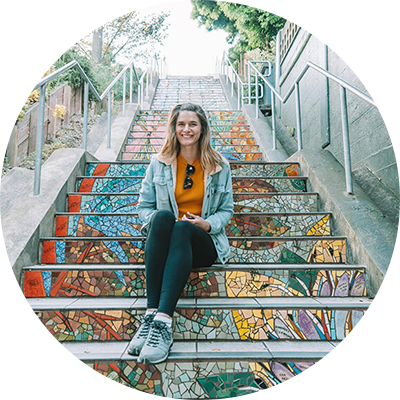A comprehensive guide to the best (and worst) hot springs in Mammoth Lakes.
Natural hot springs can be a great way to relax with friends. They can also provide epic photo opportunities and serve as a healing place for many.
The whole eastern side of the Sierra Nevada mountains is very volcanic and geothermal.
The Long Valley Caldera sits just on the east side of Highway 395, which is why there are so many beautiful hot springs around Mammoth Lakes. A caldera, by the way, is a depression left behind by subsiding volcanic activity.
If you Google “hot springs in Mammoth Lakes,” you’ll find a list of many popular hot springs but, unfortunately, many of those hot springs aren’t available anymore as of 2022.
A lot of them have become temporarily dry, closed, or so trashed that they aren’t worth visiting anymore.
This is all to say that without doing research, you may find yourself on a wild goose chase for an open tub!
To prevent that, I’ve created a guide for the best hot springs in Mammoth Lakes below, including which ones are still open and how to find them.
Plus, I included all of the essential pieces of hot tub etiquette you’ll need to keep these areas clean and enjoyable for the next folks.
Note: this post contains affiliate links, which help run this site at no extra cost to you so I can keep providing free travel advice and tips.
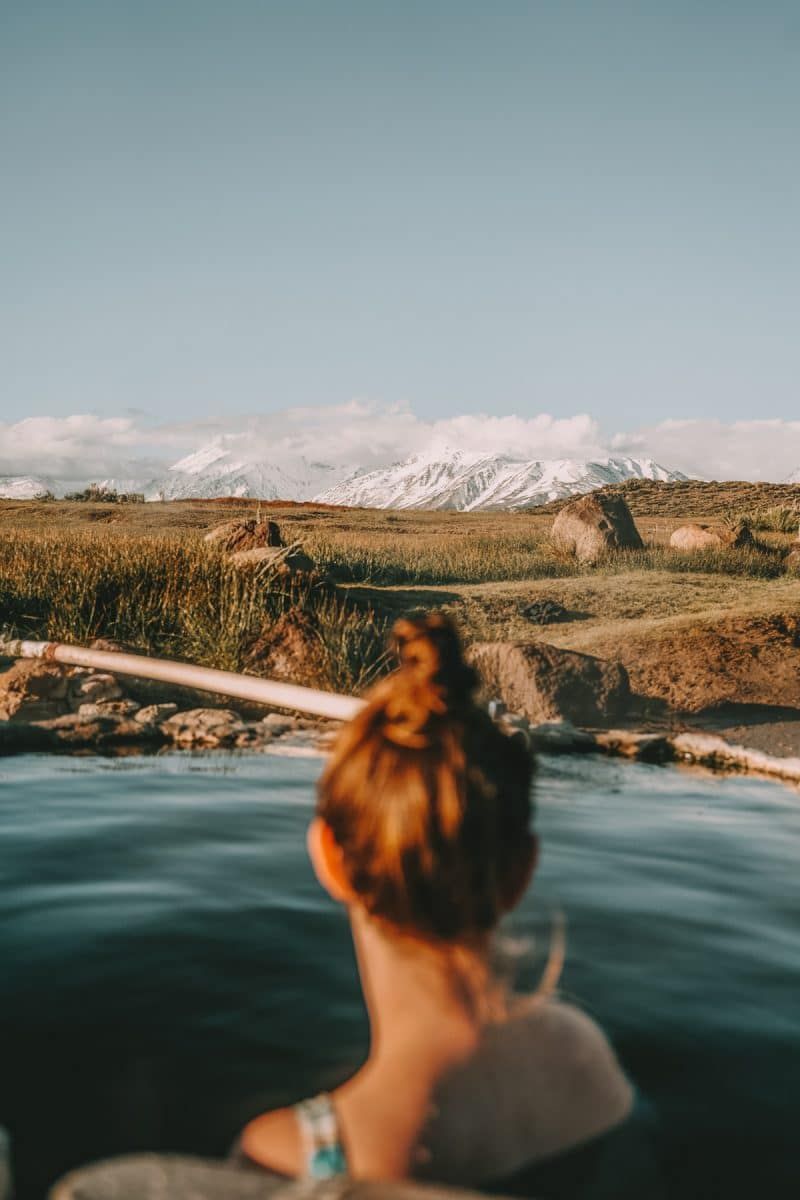
My Experience With Mammoth Lakes
Mammoth Lakes is one of my favorite places! It’s quieter than the western side of the Sierra Nevada and we try to go a few times each summer.
Mammoth Lakes has lots of things to do outdoors–Mammoth Mountain is just one of them!–plus some tasty places to eat. And of course, it’s also just a gorgeous place to boot!
I’ve also “hot sprung” all over the western United States and I have some “hot tips” to share on having a successful spring sesh.
If you’re looking for more things to do in Mammoth besides just hot springs, you can check out my detailed article on the best things to do in Mammoth Lakes.
Get your FREE California Travel Planner – including printable checklists and my favorite two-week itinerary for the state.
Mammoth Lakes Hot Springs Map
Best Hot Springs in Mammoth Lakes
Shepherd Hot Springs
Why it’s worth visiting: It’s open!
Location: (37°40’00.9″N 118°48’12.2″W); Google Maps.
Directions & parking: From Highway 395, take Benton Crossing Road east (away from the mountains), then left on Whitmore Tubs Road. Then, take the 5th right turn onto a dirt road. Park right next to the spring on the dirt road.
Capacity: 4-6 people.
Temperature: ~100 degrees F.
Shepherd Hot Springs is just one of the natural hot springs in the Mammoth Lakes area, located in the cluster of hot springs southeast of town. It’s sadly also one of the few that’s still open in this area.
This Mammoth Lakes hot spring can fit 4-6 people and is often busy. Like other hot springs in the area, this tub has been cemented in and is fed by a nearby spring source through a pipe.
The pipe that feeds Shepherd Hot Springs conveniently has an on/off valve on it, so you can generally control the water temperature too.
It’s a good idea to carefully test the water in natural hot springs like this because if the last group left the valve on, the water could be scalding hot.
Shepherd Hot Springs is within walking distance of Crab Cooker Hot Spring, so hopefully, when Crab Cooker becomes operational again, you can bounce between the two.
Hilltop Hot Spring (aka Pulky’s Pool)
Why it’s worth visiting: It’s accessible by low-clearance vehicles with an adjustable water temperature.
Location: (37°39’37.7″N 118°47’20.6″W); Google Maps.
Directions & parking: Park in the lot near the wooden and gravel path then walk the path about a quarter mile towards the spring.
Capacity: 4-6 people.
Temperature: 104-108 degrees F.
Hilltop Hot Spring is another one located near Crab Cooker and Shepherd Hot Springs and is also one of the very popular Mammoth Lakes hot springs.
The road to Hilltop Hot Springs is paved except for the last 250 yards, so it’s Prius friendly.
This tub has been cemented in and is about two feet deep. The pipes that bring the water in are adjustable too.
This pool has been marked specifically as clothing-optional, so be aware of that. It’s unfortunately also been on-and-off trashed in the past, so it can be hit or miss at times.
Wild Willy’s Hot Springs (aka Crowley Hot Spring)
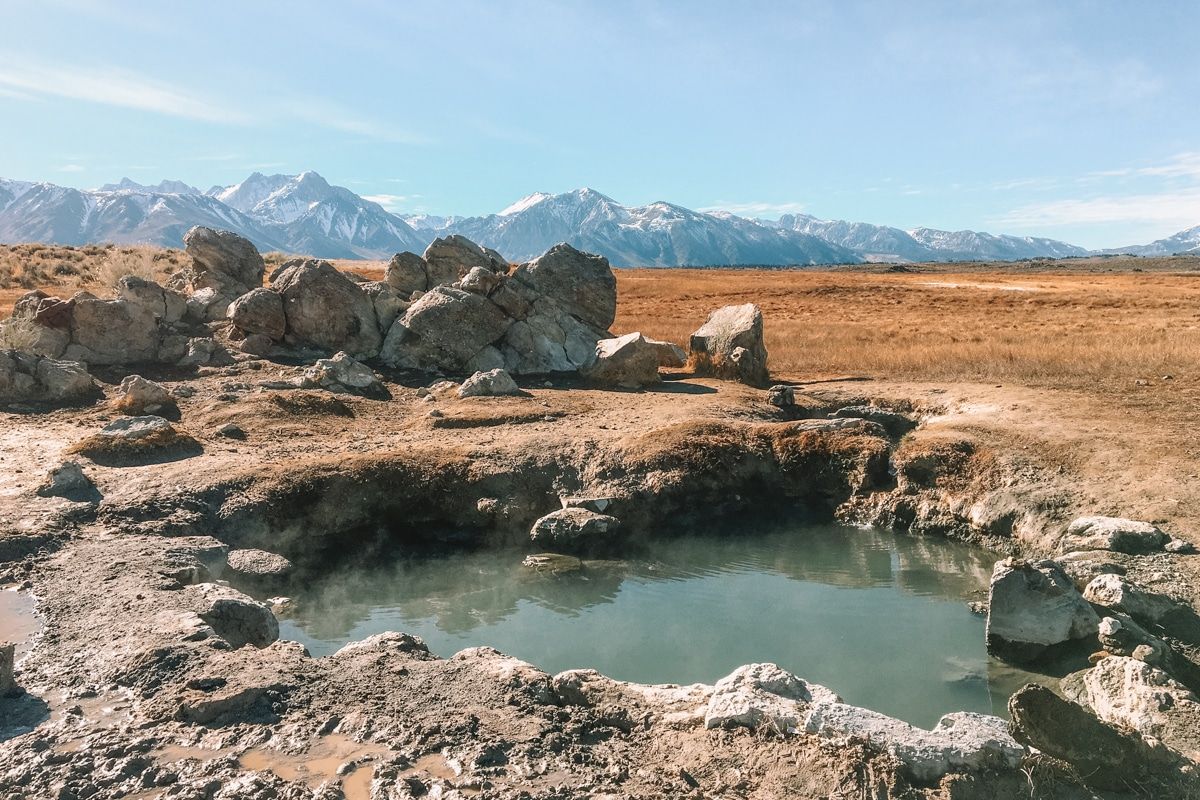
Why it’s worth visiting: It’s one of the biggest natural hot springs in the area.
Location: (37°39’32.6″N 118°46’15.5″W); Google Maps.
Directions & parking: Park on the road near the wooden boardwalk.
Capacity: 15-30 people.
Temperature: 95-105 degrees F.
Wild Willy’s Hot Springs, also known as Crowley Hot Springs, are the biggest of the Mammoth Lakes hot springs – these two pools can fit around 30 people.
Winter is an awesome time to visit Wild Willy’s Hot Spring because the access road is just 1.5 miles each way and quite flat, so it’s easy to walk to even if the road is closed.
Once you reach the main hot spring area, you’ll cross a gravel and wooden boardwalk to get to the two pools.
These boardwalks are in place to protect the fragile ecosystem around the pools from degradation, so please stay on them.
Also, these are natural pools, not cemented in, so be sure to wear some water shoes!
Layton Hot Springs
Why it’s worth visiting: It’s a large, clear spring that not many people know about (for now).
Location: (37.63636, -118.72511); Google Maps.
Directions & parking: Park in the wide turnaround on Layton Springs Road and walk down the trail across from the parking lot for about five minutes.
Capacity: 20+ people.
Temperature: Unknown.
A hot spring that I haven’t had a chance to visit myself yet, Layton Hot Springs is located on the south side of Lake Crowley.
And despite being able to see a spring on Google Maps, there’s not much information on this hot spring aside from a few home videos without any narration.
That could mean one of two things: either no one knows about it yet or it’s not worth visiting.
From the videos and photos I saw, however, this looks like a big, clear spring with people having a good time.
I couldn’t find details on the water temperature but recent visitors were all quite positive and said the temperature was pleasant.
Based on the reviews and lack of negative information about Layton Hot Springs, I’d say it’s worth a try.
Hot Creek Geologic Site
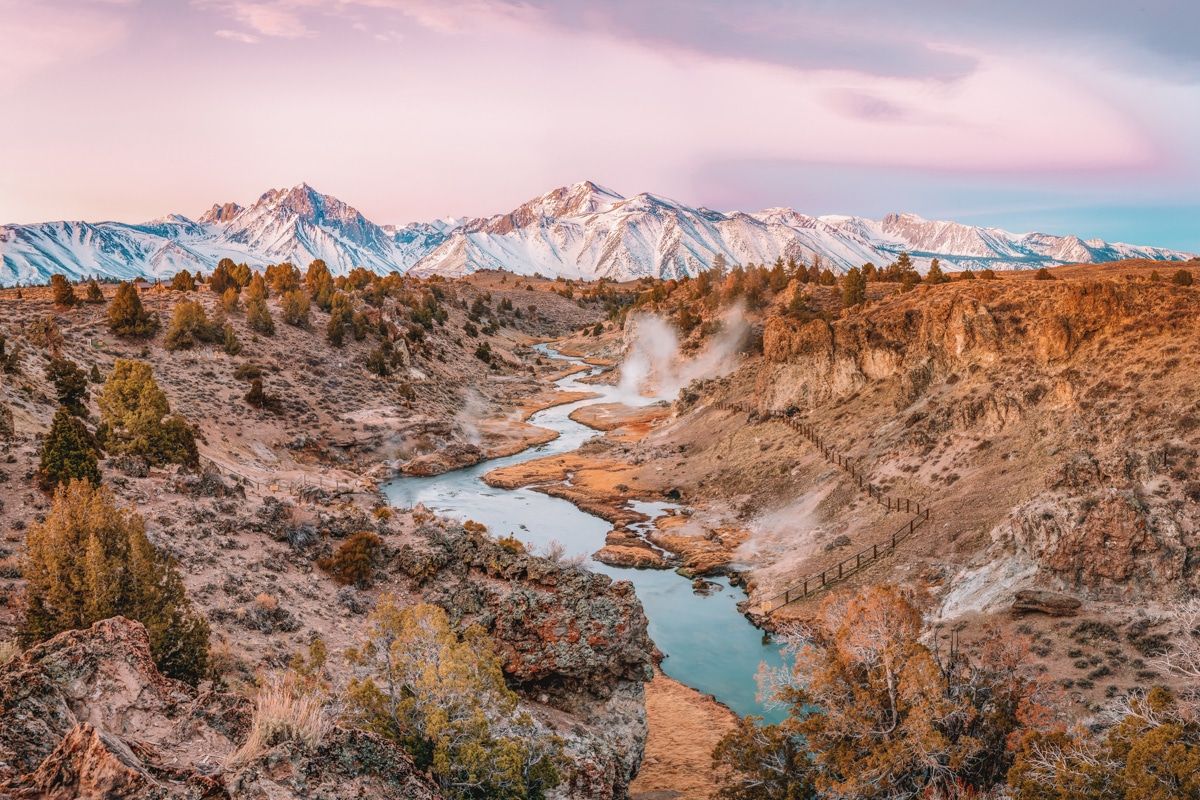
Why it’s worth visiting: See a unique geologic feature for free!
Location: Google Maps.
Directions & parking: Turn onto Hot Creek Hatchery Rd and follow the signs for Hot Creek Geologic Park. The road is a mix of paved and dirt but the dirt portion was in good condition when I drove it last.
Temperature: 199 degrees F.
Hot Creek Geological Site is not a hot spring you can bathe in. Seriously, it’s so hot that 16 people have died in these waters since 1978, so don’t even think about it!
When I visited, there were signs everywhere telling people to keep out and yet there were several groups right next to the boiling pools.
That said, it’s still a super neat area to visit. At Hot Creek Geological Site, you can see boiling water and fumaroles (boiling vents). The main feature is two turquoise blue pools at the bottom of a stream drainage.
The water coming to the surface at Hot Creek has spent an estimated 1,000 years underground, working its way through a complex system of vents and tiny cracks in the earth.
The whole eastern Sierra experiences mini earthquakes all the time and if one happens while you’re at Hot Creek, you may even see a little geyser eruption!
Best Hot Springs Near Mammoth Lakes
There are other hot springs outside the Mammoth Lakes area and these are the best ones a short drive away.
Travertine Hot Springs
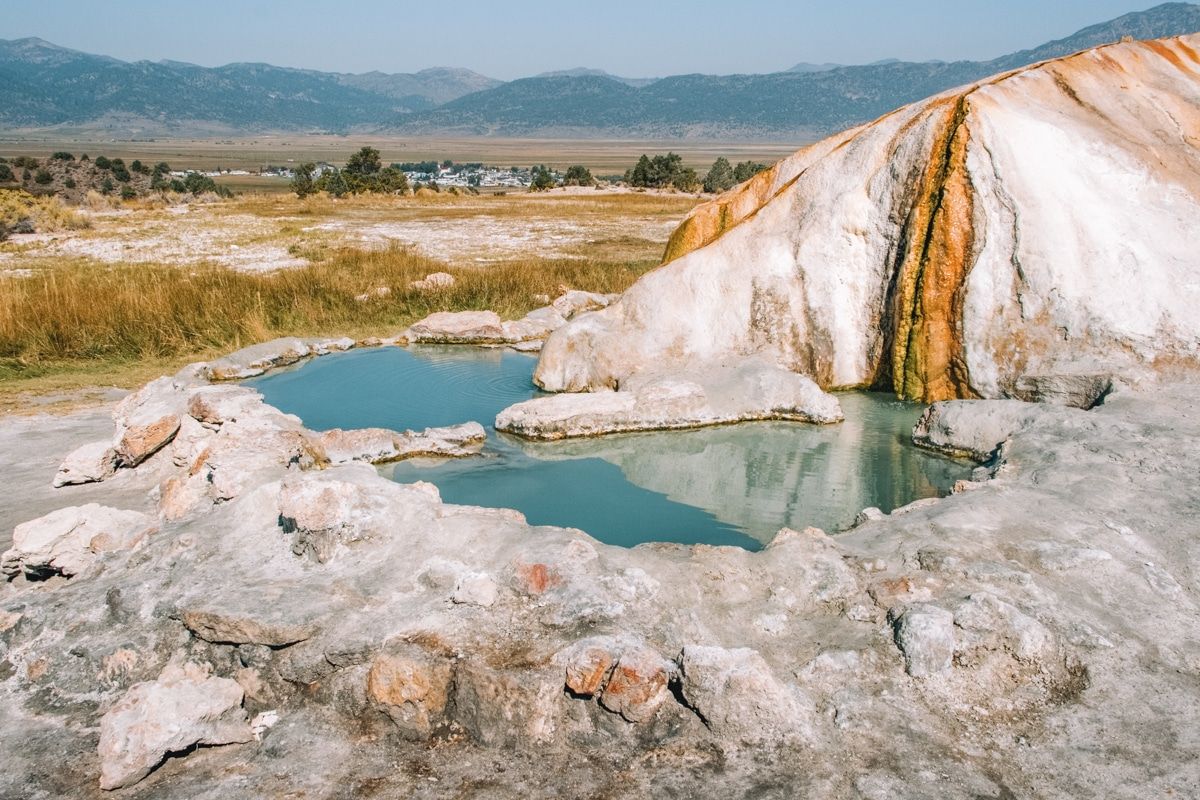
Why it’s worth visiting: There are several pools, plus you get to see a unique geologic feature (travertine).
Location: (38.24562, -119.20514); Google Maps.
Directions & parking: About an hour north of Mammoth Lakes. Take Travertine Road (or Jack Sawyer Road) off Highway 395, south of Bridgeport, CA. The springs are at the end of the road, where you can park and take the short trail to the tubs.
Capacity: 10+ people.
Temperature: 80-125 degrees F.
Travertine Hot Springs, outside Bridgeport, CA, is about an hour from Mammoth Lakes on the east side of Highway 395.
Located a few miles down Travertine Road/Jack Sawyer Road (the two roads conjoin), these pools are one of the local favorite hot springs.
Despite it being a dirt road, the road is well maintained and easy to get down in a low clearance vehicle (when it’s dry).
There’s also a pit toilet here, which is rare because most hot springs don’t have amenities like that.
One of the most unique things about these pools is the travertine deposits. Travertine is a type of limestone that makes beautiful formations around the hot springs.
There are several pools to soak in here, but some of them might be too hot to dip your feet in, so enter with precaution.
Another reason Travertine Hot Springs is so popular is the view: you’ll look out to the Sierra Nevada mountain range to the west.
Just like the hot springs right next to Mammoth Lakes, Travertine Hot Springs sits on BLM land. There’s no camping directly adjacent to the springs, but you can camp elsewhere on the BLM land.
Buckeye Hot Springs
Why it’s worth visiting: There’s a campground nearby so you can easily make a night of it.
Location: (38.23948, -119.32552); Google Map.
Directions & parking: Go west off Highway 395 onto Buckeye road. There’s a big dirt parking lot to the left of the road before you hit Buckeye Campground.
Capacity: 10+ people.
Temperature: ~100 degrees F.
Buckeye Hot Springs is located on the west side of Bridgeport, CA, down Buckeye Road.
One thing to note–this road can be quite difficult to navigate without a four-wheel drive and the road is gated in the winter.
Buckeye Hot Springs is comprised of three pools that are between Buckeye Creek and the steep canyon hillside.
This is also a very popular Sierra hot spring, although not quite as popular as Travertine Hot Springs.
Buckeye Hot Spring is another clothing-optional hot spring and the hike from the road is super steep. However, one nice thing about this hot spring is the developed Buckeye Campground nearby.
Keough’s Hot Springs
Why it’s worth visiting: It’s the biggest hot spring in the Eastern Sierra.
Location: 800 Keough Hot Springs Rd, Bishop, CA 93514; Google Map.
Directions & parking: Get off Highway 395 south of Bishop and go west on Keough Hot Springs Rd.
Capacity: 50+ people.
Temperature: Varies, but up to 104 degrees F.
Keough’s Hot Springs is a developed hot spring just south of Bishop, CA, which is just under an hour south of Mammoth Lakes.
I should also note that there are two hot springs by the name “Keough Hot Springs.” There’s “Keough Hot Springs,” which takes you to an undeveloped hot spring, and there’s “Keough’s Hot Springs”, which is a developed facility.
For this article, I’m talking about Keough’s Hot Springs, which is the developed one. Although, if you’re more interested in the undeveloped spring, it’s located just outside the developed facility.
Keough’s Hot Spring includes several large pools, such as the “large pool,” which is kept to 86-92 degrees F, and a Hot Pool, which is a steamy 104 degrees F. Both are surrounded by deck chairs to lounge on.
The facility was built in 1919 and today offers water aerobics and lap swimming. For sanitation purposes, the pools are drained and cleaned each week.
There’s also a small, shady campground at this facility with tent camping and RV sites, plus a few tent cabins to rent.
Iva Bell Hot Springs
Why it’s worth visiting: A beautiful, secluded wilderness respite.
Location: (37°31’53.7″N 119°01’31.5″W); Google Maps.
Directions & parking: Hike in over a 2-3 day backpacking route (see below) starting from Red’s Meadow or the Duck Pass Trailhead. Trail guide.
Capacity: 10+ people.
Temperature: Varies (there are multiple pools with each pool getting hotter as you continue uphill).
This is a hot spring that I haven’t ventured to myself yet, but I wanted to include it for those who are looking for a more secluded hot spring experience.
The reports on the Iva Bell Hot Springs are very mixed, but the latest reports seem to indicate that the pools are mostly dry (or very muddy) and quite buggy. However, this could also be due to hikers going during peak summer when bugs are the worst.
There are three ways you can get to the Iva Bell Hot Springs and all three are quite strenuous.
You can do a three-day backpacking route starting at Duck Pass and ending at Red’s Meadow or a 28-mile out-and-back loop from Red’s Meadow. Or, you could do an out-and-back trip from Duck Pass via the Minnow Creek Trail.
If you’re psyched on backpacking and don’t mind *not* having a hot spring along the way, this is still a beautiful hike in the Eastern Sierra.
This is also one of the few hot springs in Mammoth Lakes that needs a wilderness permit. This is because the hike is in Inyo National Forest.
All the springs here are on a hill, with the pools getting hotter as you get closer to the top.
Mono Hot Springs Resort
Why it’s worth visiting: They have a licensed massage therapist on staff, for one!
Location: 70 miles northeast of Fresno, CA; Google Maps.
Directions & parking: Located deep in the Sierra Nevada Mountains. Click here for directions.
Capacity: 100+ people.
Temperature: 100-104 degrees F.
The Mono Hot Springs Resort is a summer campground/cabin facility with a developed bathhouse for steaming.
Unfortunately, this resort isn’t accessible from the eastern part of the Sierra. So, while it looks like it’s close to Mammoth Lakes on the map, you’ll have to drive over the mountains and enter from the west.
That said, this is a great, family-friendly place to visit. This facility is dog-friendly, there’s a general store, a restaurant, and a post office. You can camp here or rent a private room with a mineral water bathtub.
Benton Hot Spring
Why it’s worth visiting: It’s a great opportunity to unplug and relax.
Location: 55137 Highway 120, Benton CA; Google Maps.
Directions & parking: Take Highway 120 towards the town of Benton, CA.
Capacity: 50+ people.
Temperature: Unknown.
Benton Hot Springs is a developed hot spring facility close to the Nevada border. The facility is about an hour from Mammoth Lakes and offers an inn as well as small cabins to rent and campsites with private hot tubs.
The facility is located on a family ranch and will give you “way out there vibes.”
The tiny settlement of Benton was originally a Paiute native settlement until silver was discovered there in the mid-1800s.
The remnants of the old town are ghostly and there’s no cell service here so be prepared to unplug if you choose to go!
You should just note that Benton Hot Springs is extremely popular and gets booked up many months in advance.
While the website says the source water for the hot springs is 140 degrees F, I couldn’t find detailed information on the temperature of the pools themselves. Suffice it to say, they should be hot enough!
Additional Hot Springs in the Mammoth Lakes Area That Probably Aren’t Worth Visiting
Below is a list of hot springs in Mammoth Lakes that used to be popular.
However, these are either no longer functional or open to the public anymore, or they’ve become so trashed that I can’t in good conscience send you there.
I hope one day soon these natural hot springs will be returned to their former glory!
Whitmore Hot Springs
Location: Google Maps.
Directions & parking: Park just off Benton Crossing Road.
Capacity: 4-6 people
Temperature: 100 degrees F+.
Whitmore Hot Springs is not a single hot spring but rather the general location for a large upwelling of geothermal activity in the whole region.
If you Google “Whitmore Hot Springs,” you’ll see a pin located just south of the Mammoth Yosemite Airport.
You’ll also see a chlorinated community swimming pool called the Whitmore Pool, and this is about as good as you’ll get in terms of soaking opportunities near the “Whitmore” area.
You’ll even see a location called “Whitmore Tub” in the area, but there’s not an actual hot spring there either.
Some blogs have used the name “Whitmore Hot Springs” to describe the “Rock Tub Hot Springs,” but they’re not the same either.
Rock Tub Hot Springs
Why it’s worth visiting: It’s a small, cozy tub with beautiful views of the Sierras.
Location: (37°38’51.2″N 118°48’29.0″W); Google Maps.
Directions & parking: Park on the road right next to the hot spring.
Capacity: 1-3 people.
Temperature: ~100 degrees F.
The Rock Tub Hot Springs is the smallest of the Mammoth Lakes hot springs.
It only fits about three people max and because it’s so easy to get to, it’s often full. That said, if you’re lucky enough to get it to yourself, it would be a lovely, cozy experience.
This pool is cemented in and approximately two feet deep. The water in this pool doesn’t have a sulfury odor you can sometimes get with natural hot springs, which is a plus.
Camping isn’t allowed next to the hot spring, but this doesn’t usually deter people. Since it’s surrounded by BLM land, you can camp farther down the road if you wish.
The Rock Tub is temporarily closed right now, but keep it on your radar for future visits!
Crab Cooker Hot Springs
Why it’s worth visiting: Crab Cooker Hot Spring is situated in a beautiful green meadow.
Location: (37°39’46.2″N 118°48’00.6″W); Google Maps.
Directions & parking: Park at the end of the dirt road and take the dirt path on the right side of the road down to the hot spring. The hot spring isn’t too far away.
Capacity: 5-7 people.
Temperature: 105 degrees F (when the pool is working).
The most updated report about Crab Cooker Hot Springs as of June 2022 is that it isn’t working, and hasn’t been for at least a year.
When it was operational, this little round spring sat in a wide meadow with the Sierra Nevada Mountains in the distance. It was one of many hot springs in Mammoth Lakes located in the Long Valley Caldera.
You’ll often see this spot listed in articles about Mammoth Lakes hot springs because it was once one of the most popular hot springs in the area.
It’s too bad Crab Cooker Hot Spring isn’t full anymore because it was one of the hottest Mammoth Lakes hot springs. It was so hot you could burn yourself if you weren’t careful.
The pool is made of stones cobbled together with cement and was about two feet deep when it was working.
Reds Meadow Hot Springs
Why it’s worth visiting: You can camp at the Red’s Meadow Resort nearby.
Location: (37°37’04.7″N 119°04’23.5″W).
Directions & parking: Park at the Reds Meadow Resort.
Capacity: 1-2 people.
Temperature: Unknown.
The Reds Meadow Hot Springs is located on the west side of Mammoth Lakes, near the Reds Meadow Resort.
This campground and general store are a major stop-off for those hiking the Pacific Crest Trail. The Reds Meadow Hot Springs is just 200 yards behind the campground in Inyo National Forest.
These natural hot springs used to have bathhouses connected to the spring, but in recent years, the bathhouses have been shut down due to safety concerns about the water.
I couldn’t find too much more information about this hot spring but from what I’ve seen it’s a very small tub (about 1-2 people max).
Casa Diablo Hot Springs
Location: (37°38’44.6″N 118°54’59.0″W); Google Maps.
Directions & parking: Park on Hot Springs Road next to the geothermal plant.
Capacity: N/A.
Temperature: Unknown.
I’m including this short blurb about the Casa Diablo Hot Springs because the name seems to pop up when you search for hot springs in Mammoth Lakes.
Unfortunately, there’s no soakable hot spring near the spot labeled “Casa Diablo.”
There’s a geothermal power plant that harnesses the immense power of the very hot water, and there used to be a geyser here that went off routinely. However, there’s no tub to soak in.
Little Hot Creek
Location: (37.69203, -118.84213); Google Maps.
Directions & parking: Take Highway 395 to Benton Crossing Road, turn left onto Whitmore Tub Rd, then left onto Owens River Rd.
Capacity: 1-2 people.
Temperature: Unknown.
This hot spring is listed in the area, you’ll see it on Google maps, but the most recent reviews of this spot are quite bad.
At least one person mentioned human feces, several people mentioned that the tub ran cold, and others said it was muddy and smelled bad with dead animals floating in it.
There are two places on Google maps with the name Little Hot Creek and they’re both near each other, both with similarly bad reviews.
Perhaps at one time this was a good spot to go. Hopefully, one day in the future it will be again, but for now, you’re probably better off spending your time elsewhere.
Best Time to Visit Hot Springs in Mammoth Lakes
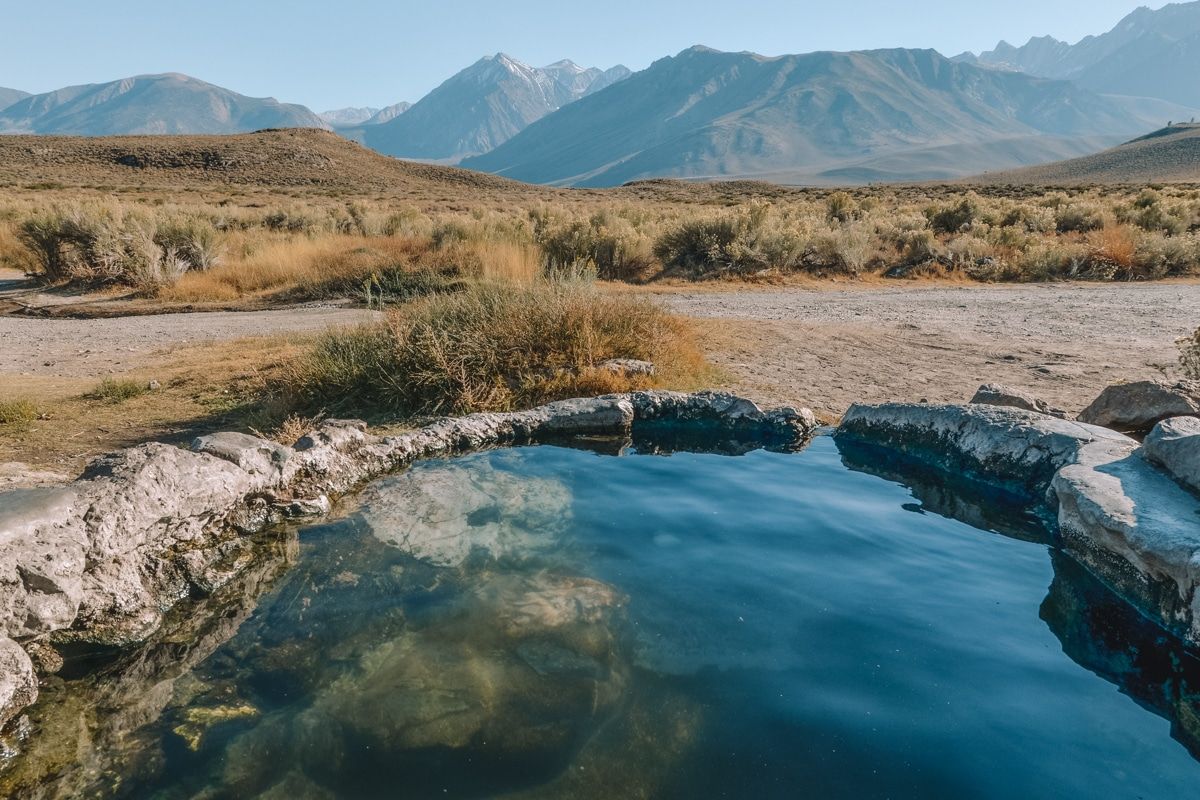
The best time of year to visit these Sierra hot springs is in early spring or late fall.
I don’t like to visit hot springs as much in the middle of the summer because it’s too hot. And although it can be nice to visit Mammoth Lakes hot springs in winter, road closures due to snow can be common.
However, the shoulder seasons are a great time to visit because the air temperature allows you to enjoy the hot water longer and roads are more accessible.
The best time of day to visit natural hot springs depends on what mood you’re in.
If you want to hang out with other people, nighttime is a popular time to visit hot springs. Early mornings tend to be quieter times to visit, so if you’re interested in a solo retreat, go then.
Looking for more hot spring options? Read our guide to the best California hot springs.
Hot Springs Etiquette 101
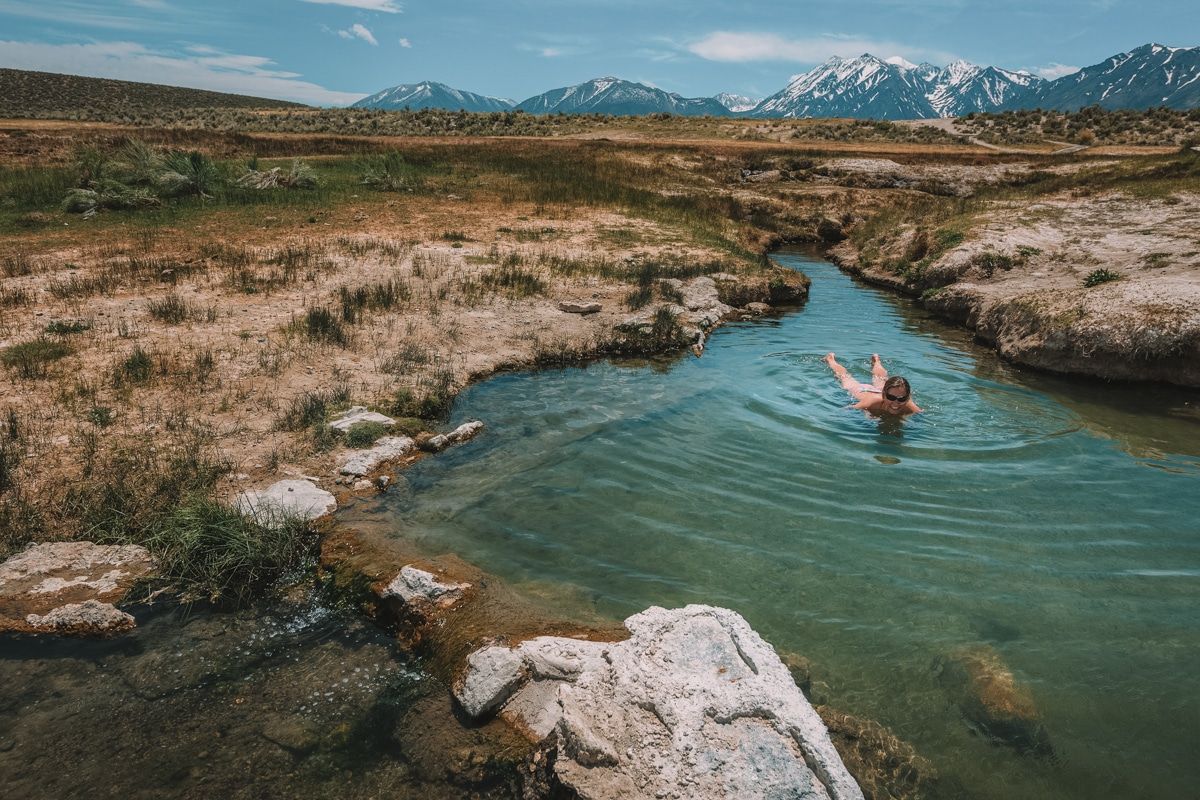
The first thing to understand about many hot springs on public lands is that there won’t be lifeguards, rangers, or hosts to keep the place tidy or to keep people safe.
Therefore, it’s up to you to be as respectful as you can while you’re there.
Too many times I’ve visited free hot springs only to find them completely trashed with graffiti, litter, underwear, you name it.
In my research for these hot springs, I routinely saw some pretty gross and sad stuff left at these hot springs, which is why hot spring etiquette is SO IMPORTANT.
It’s also important to remember that many of these hot springs are *old,* and were sacred places for the indigenous people who came before us.
I strongly encourage anyone visiting these hot springs to treat them with the utmost respect and thoughtfulness.
Get In Slowly
Always test the water temperatures in a natural hot spring slowly and carefully before you jump in.
Pack Out All Trash
If you take it out, make sure it leaves with you! Plain and simple. Bonus points if you want to bring a trash bag and do a good deed for the hot spring while you’re there.
Don’t Bring Glass Bottles
Most beaches have this rule for one simple reason: broken glass shards are impossible to remove from sandy, muddy waterways and pose a hazard to people for a long time to come.
Clothing is (Usually) Optional
In most hot springs I’ve visited, there’s been a naked person. As I mentioned above, there are unspoken rules around most hot springs, and being clothing optional is usually one of them.
Wash Off Hygiene Products Beforehand
Natural hot springs are very delicate places, ecologically, and the lotion, deodorant, and sunscreen you have on can disrupt the mineral balance in the water.
Fancy spas make you shower before entering the sauna for the same reason and the best commercial hot springs will drain their tubs regularly to avoid the buildup of too much “humanness.”
I should also note that this is especially true about doing a #1 in the hot spring. Just don’t! Find a spot far away from the hot spring to do your business, please.
Leave Your Furry Friend At Home
A hot spring is not a good place for a dog.
Dogs can introduce pests to the water (fleas, mites, even viruses that can spread to wildlife!). They can also be disruptive, scary, or even dangerous to others (even nice dogs may nip if they’re approached by a stranger).
It’s also a lot harder to control where your dog pees, and for reasons that should be obvious by now, that’s no good near natural water sources.
Wear Water Shoes
It’s always best to protect your feet in a hot spring with a good pair of water shoes. Even if there isn’t glass in the pool, the rocks around the edges can be slick.
Be Considerate of Others
Hot springs aren’t the space to hold a raging party. Not only do other people find it obnoxious, but if it gets too out-of-hand, the area will sometimes be closed for a while afterward.
Be Mindful of Photo Opportunities
If you’re in a hot spring by yourself, it’s fine to take photos. However, be mindful of your photo angles if there are other people there, especially if they’re nude.
Many people use hot springs as a place to heal and relax, so just because they’re nude in a semi-public place doesn’t mean they want their business on the internet!
Don’t Submerge Your Head
Ok, not to get like, too real and crazy here, but you should never submerge your head in hot spring water?
Why? Because there’s a brain-eating amoeba in freshwater springs called Nigella fowleri. Eek! See?? I told you I didn’t want to get too real.
Nigella fowleri infections are rare, but they’re deadly and there have been a few in the eastern Sierra in the last few years. These can be avoided if you just keep water from getting in your nose.
Other Tips for Visiting Mammoth Hot Springs
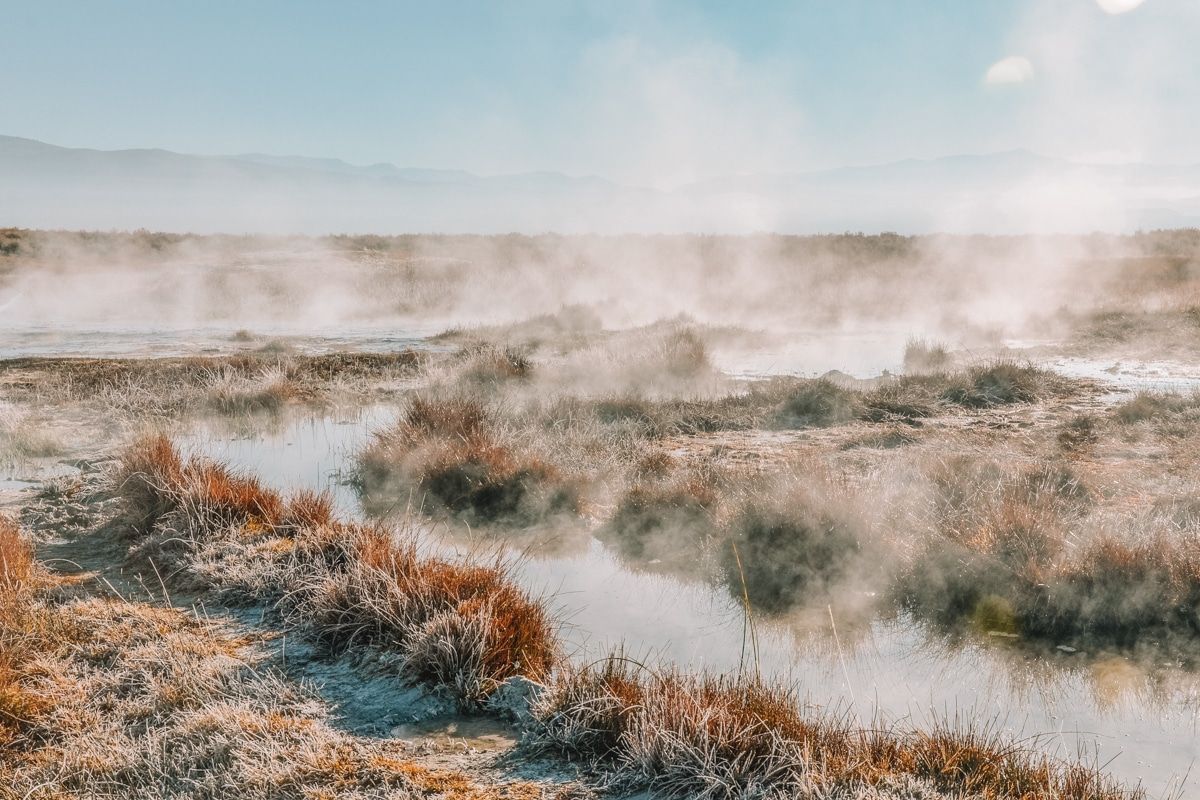
Bring Layers
The Mammoth area is gorgeous, but it can be windy and cool at night. Be sure to bring more layers than you think you’ll need.
Download Maps Ahead of Time
The town of Mammoth Lakes has great cell reception but in the outer lying areas, not so much. Download your maps ahead of time or use an offline navigation app.
Know When the Roads are Open
If you’re visiting Mammoth Lakes from San Francisco, or anywhere on the western side of the Sierra Nevada Mountains, know that there are relatively few mountain highways that cross these giant mountains. They’re also often closed all winter.
Even if you’re already on the east side of the Sierra, some local roads will be gated during the winter to prevent people from getting stuck. No matter where you’re coming from, check to make sure the road you need will be open!
Where to Stay with the Best Access to Mammoth Lakes Hot Springs
Most of the hot springs in Mammoth Lakes are on the east side of Highway 395.
Mammoth Lakes is not a very big town, so you can stay almost anywhere and still have very good access to the hot springs.
Regardless, I picked some of the best accommodations on the east side of town for the fastest access to the hot tubs.
- Sherwin Villas is located on the east end of town, closer to Highway 395. It’s about 10 minutes to the start of Whitmore Tubs Road, where many of the Mammoth Lakes hot springs are.
- Mammoth Golf Properties is another excellent stay on the east side of Mammoth Lakes. It’s about 10 minutes to Whitmore Tubs Road.
- Loft in Mammoth Lakes is an Airbnb rental if that’s more your style. It’s about 10 minutes to Whitmore Tubs Road.
Camping at Mammoth Lakes Hot Springs
If you’re looking to check out the hot springs in Mammoth Lakes, you may want to try camping on the BLM land near Mammoth.
What is BLM Land?
The Bureau of Land Management (BLM) is a federal land management agency that maintains large tracts of land all over the United States.
The BLM operates traditional campgrounds and allows for “dispersed camping.” There’s a good-sized piece of BLM land south of Mammoth Lakes, to the east of Highway 395.
Note that dispersed camping is only allowed on BLM or Forest Service land. You can’t do dispersed camping at any of the national parks, including Yosemite or Sequoia National Park.
What is Dispersed Camping?
Dispersed camping is when you camp in a spot you pick yourself, rather than in an established campsite.
Can I Camp On BLM Land for Free?
Usually! Most dispersed camping on BLM is free and you can stay in one spot for up to 14 days.
Where Can I Camp on BLM Land?
Generally speaking, dispersed camping takes place next to dirt roads. If you have a high clearance vehicle, just go ahead and drive down any BLM road and see what you find!
It’s often obvious where others have camped before and you should pick a spot that looks like it’s been used before, rather than blazing your own path.
Don’t camp in areas marked as no camping zones or within 200 feet of any water source (cuz they’re sensitive and can’t take the trampling!).
You can find the BLM land near Mammoth Lakes with the Freeroam app. Read more about how to do dispersed camping on the BLM website.
Can I Have a Campfire on BLM Land?
It depends on the fire danger. You can check the updated fire restrictions here, and I can’t emphasize how important this is.
Even if there aren’t any restrictions in place, you’ll need a permit for any campfire or even a camp stove, but you can get one for free here. It only takes a few minutes to get the permit.
What to Bring to Mammoth Lakes Hot Springs
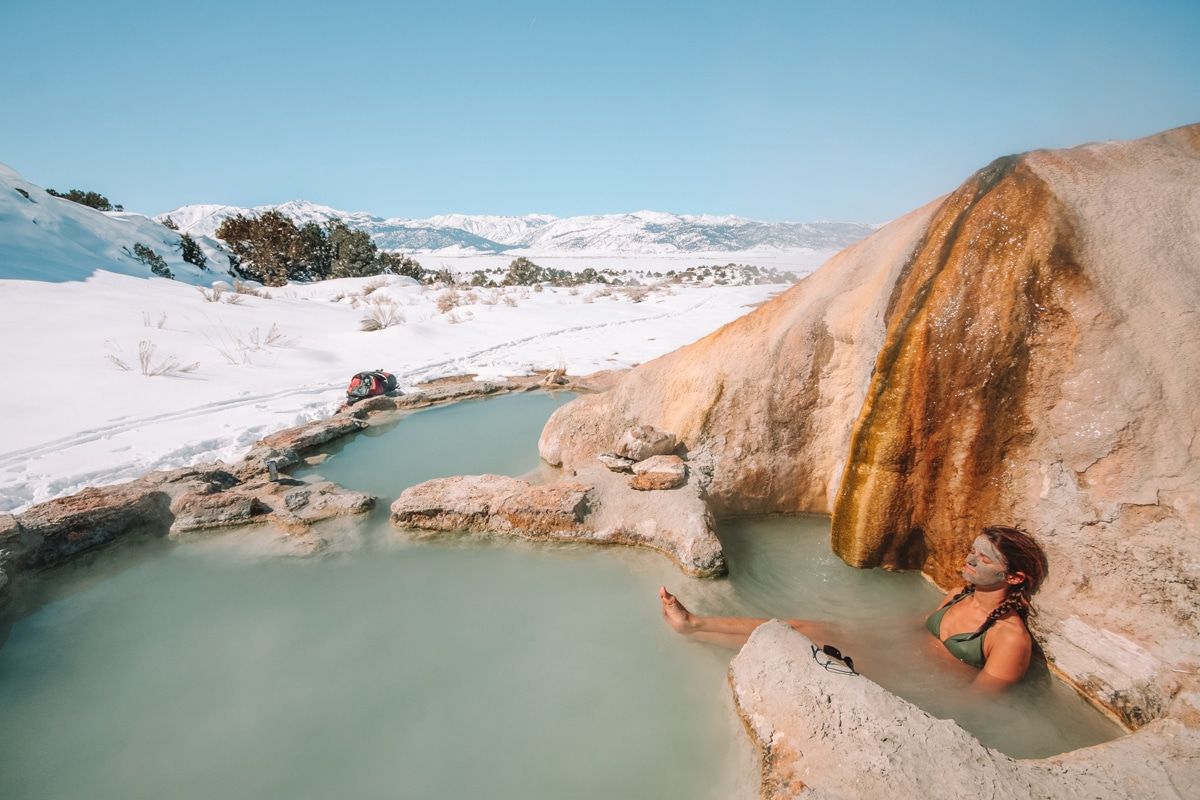
- Bathing suit (if desired)
- Towel
- Plenty of water
- GPS or navigation unit
- Hiking boots
- Hiking backpack
- Water shoes
- Wide-brim hat
- Extra clothing layers
- Sunglasses
ABOUT THE AUTHOR

Meredith Dennis
Meredith is a biologist and writer based in California’s Sierra Nevada. She has lived in 6 states as a biologist, so her intel on hiking and camping is *chef’s kiss* next level. One of her earliest camping memories was being too scared to find a bathroom at night on a family camping trip. Thankfully, she’s come a long way since then and she can help you get there too!
Looking for more Sierra Nevada travel inspiration? Read our related articles below!
Best Things to do in Yosemite National Park
9 Closest Airports to Yosemite National Park
50 Best Things to do in Lake Tahoe
Best Places for Snow in California
Romantic Getaways in California
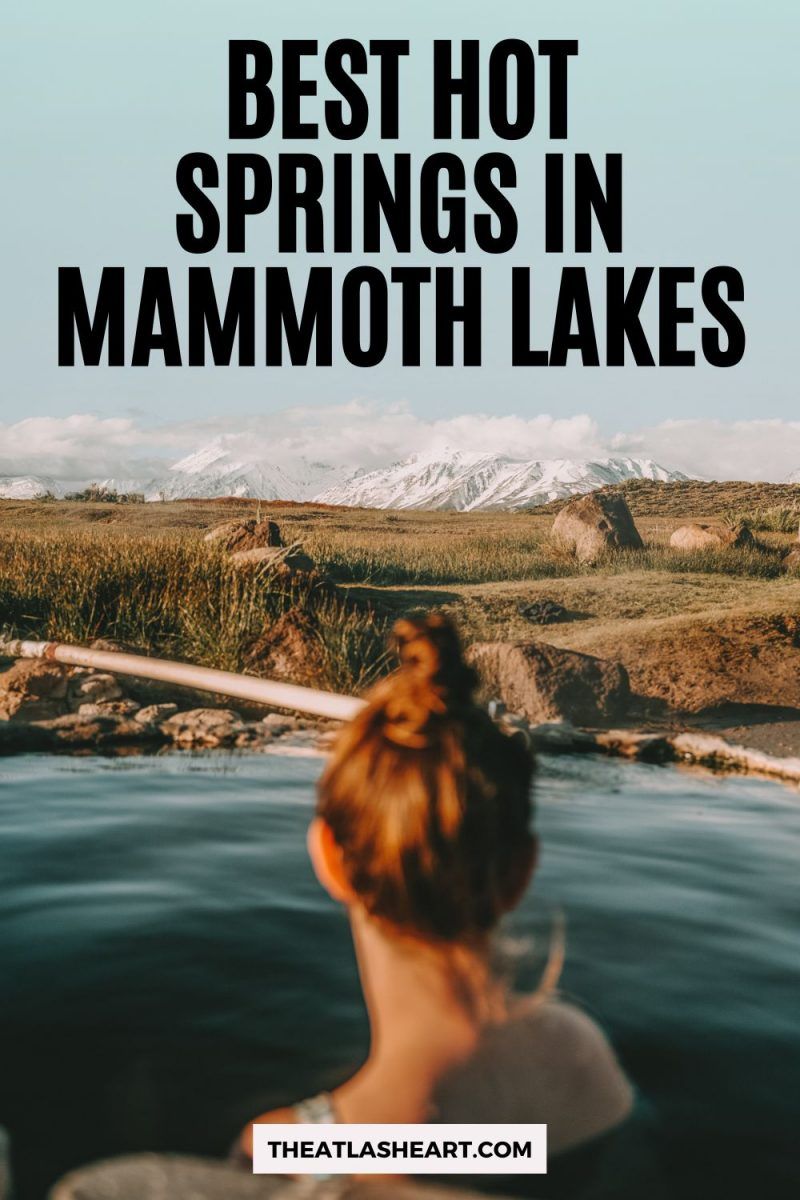
Pin this image for future reference

